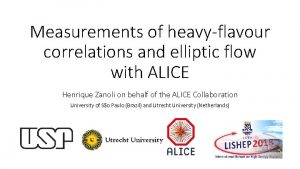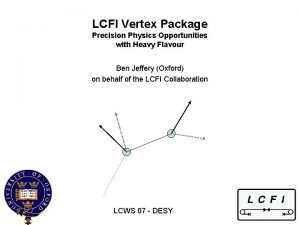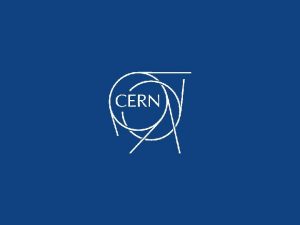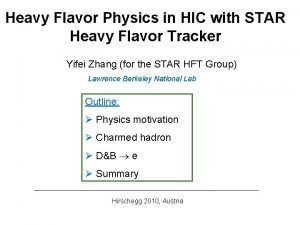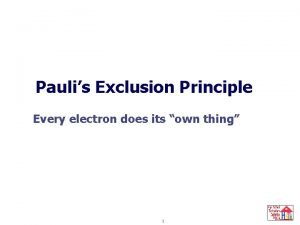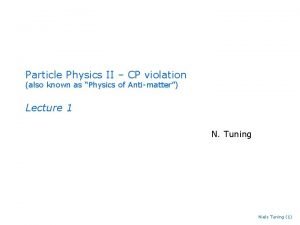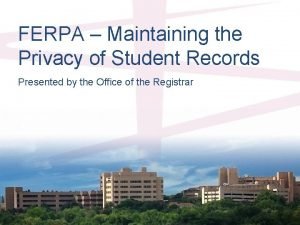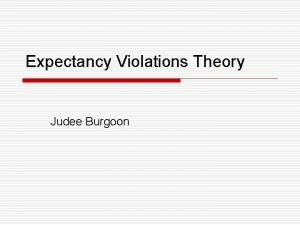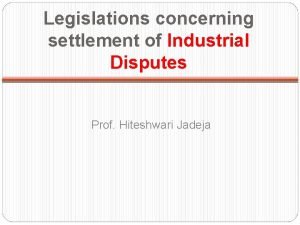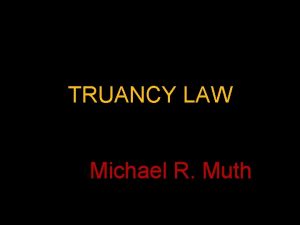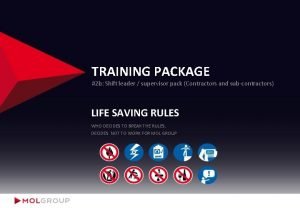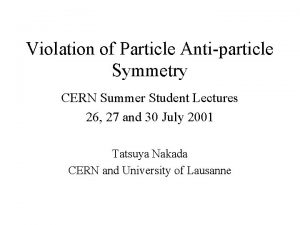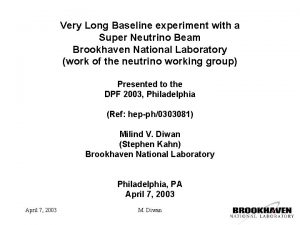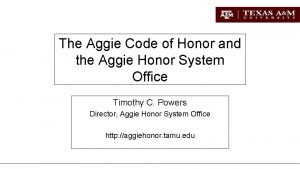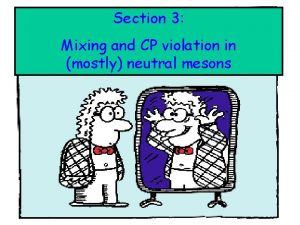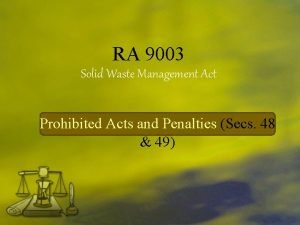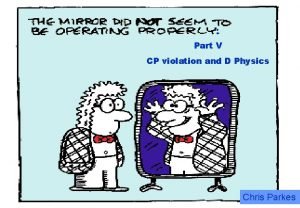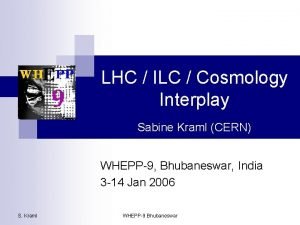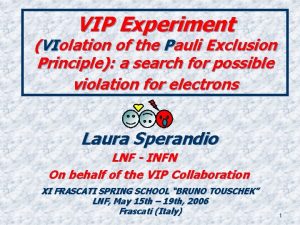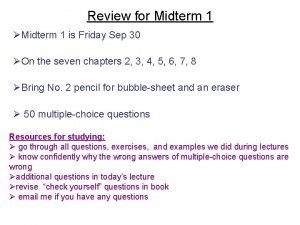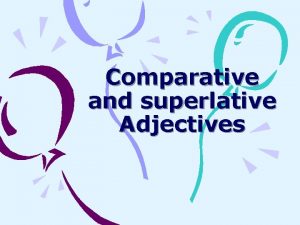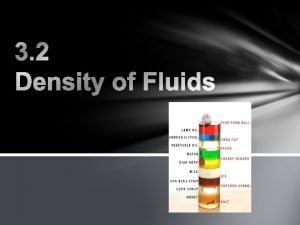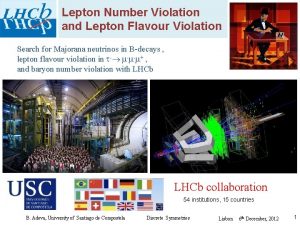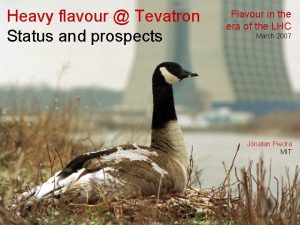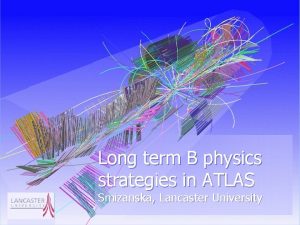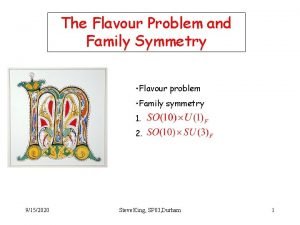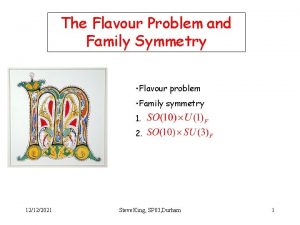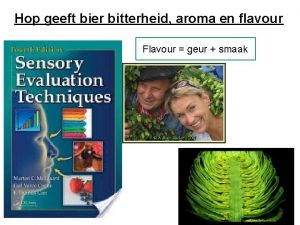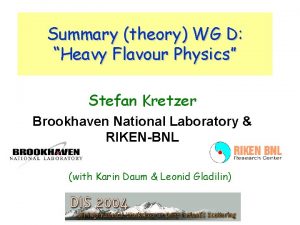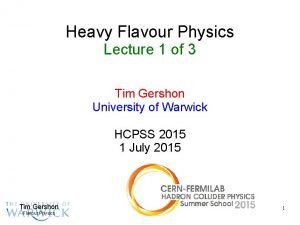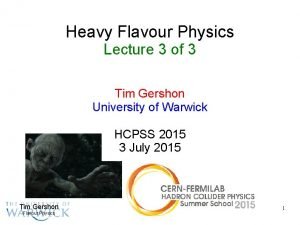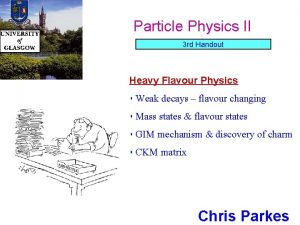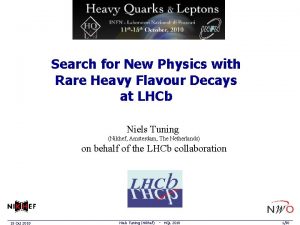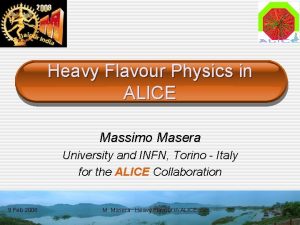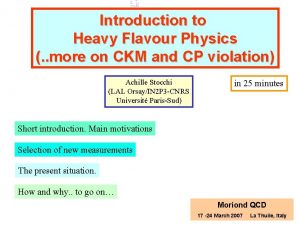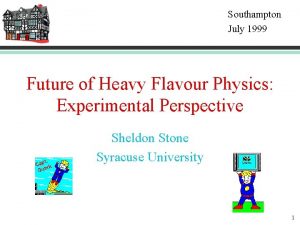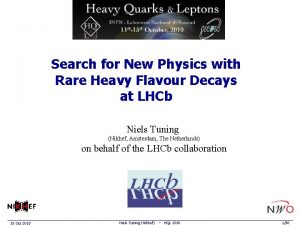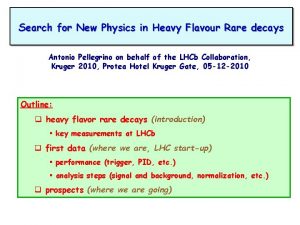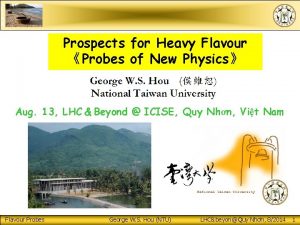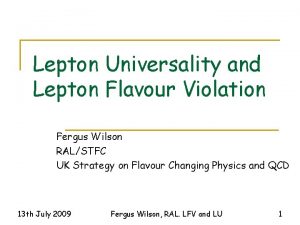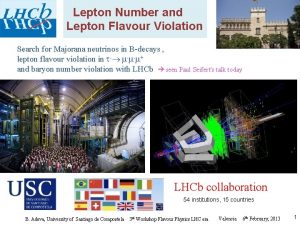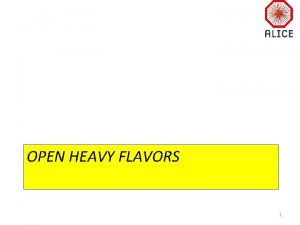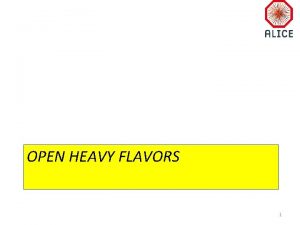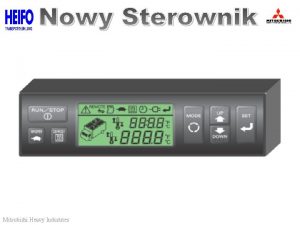Heavy Flavour physics and CP violation M Smizanska














































- Slides: 46

Heavy Flavour physics and CP violation M. Smizanska Lancaster University, UK

Inroduction Heavy Flavour (HF) physics is about: § … learning and testing the phenomenology of the Standard Model, quark-mixing physics (CKM) § … is about CP violation: § is CKM the only source of CP violation in nature ? § … is both, rare and precision physics § … is looking beyond the Standard Model ! Uncovering new physics § … will be probing flavour of new physics if discovered elsewhere § high-p. T and Flavour precision probes are complementary (Workshop: HF in the era of LHC, CERN, 2006 -2007. ) § § § Current HF lead by B-factories and Tevatron § results consistent with SM § Recent NP searches – some interesting constraints, however NP evidence need future experiments. 2008 LHC takes over and by 2013 inambigously confirm or reject NP in HF sector and start to map. Once NP found need detailed map NP in Flavor sector: § Super. B, Kek. B 2016 and upgraded LHCb (ATLAS/CMS) - 2016

Layout • Overview of most recent measurements of current experiments, combined with expected measurements with existing LHC detectors. Stress is given on rare decays and very precise measurements searching for effects of NP. • Very rare leptonic B decays B → • CPV in Bs mixing • Radiative penquin B-decays: inclusive and exclusive b →s , d ; BF and CPV • Electro weak penquin. B-decays exclusive b→ sll and angular analysis of B →K*ll • B-decay B → • Perspectives for measurement of • Future facilities and upgrades

Super KEKB Worldwide Experimental facilities current and future measuring B-physics

Achievements at B factories Observation of direct CP violation in B g p+p- Exciting results every year ! Evidence for B g tn Observation of b g d Evidence for direct CPV in B g K+p - Discovery of X(3872) CPV in B g Ks Observation of B g K(*)ll Observation of CPV in B meson system Hazumi, March 28, 2007 Flavor in the era of the LHC, CERN

Rare decay searches in B-factories comparison of current results and SM Extracted from J. Berryhill report on Rare decays WG at Flavor in the Era of the LHC

Achievements in Tevatron B phys The Tevatron has access to Bs, Bc and baryons physics program complementary to the e+e- B-factories Very fast turn around of results at the Tevatron RUN-II already showing 2. 4 fb-1 results Competitive and complementary program to B-factories Bs mixing measured Dms = 17. 77 0. 10 (stat. ) 0. 07 (syst. ) ps-1 CPV Bs mixing phase s and DGs limits sharpened Lb J/ L Lifetime First measurement of direct CPV in Bs (Bs K-p+ ) B mm limits ~10 -8 Observation of Sb , Bs K-p+ Lb p. K-Lb pp. From Jónatan Piedra, Mar 2007 in CERN, updated

Bs→ • Very rare loop decay Bs→ , sensitive to new physics: – BR =(3. 4 0. 4) 10– 9 in SM – Current 90% CL limit: • CDF note 8956 (2 ): 14*BRSM • D 0 note 5344 -CONF (2 fb– 1): 75 10– 9 = 20*BRSM fb– 1 47 10– 9 = – BR can be strongly enhanced in SUSY: • e. g. current measurement of anomalous magnetic moment of muon suggests BR(Bs + –) up to 100 10– 9 within the CMSSM for high tan see next slide SM MSSM

B s + – • Anomalous magnetic moment of the muon – Muon g– 2 collab. measurement deviates by 2. 7 from SM: a = (25. 2 9. 2) 10– 10 • Implications on Bs + – within constrained MSSM: 250 < m 1/2(gaugino mass) < 650 Ge. V BR(Bs + –) = 5 10– 9– 10– 7 [J. Ellis et al. , hep-ph/0411216] SM prediction

Bs→ §Easy for LHCb ATLAS, CMS to trigger and select §Main issue is background rejection • with limited MC statistics, indication that largest background is b b Specific BG Br B+ → µ+µ- ℓ+νℓ < 5 ∙ 10 -6 B+ → J/ (µ+µ-) + n ~ 6 ∙ 10 -5 Bc → J/ (µ+µ- )ℓ+νℓ < 10 -4 B 0 → π - µ+ ν µ ~10 -4 Bd → Kp Bs →KK 2 ∙ 10 -5 B 0 d → π0 µ+µ- ~ 2 ∙ 10 -8 B 0 s →µ+ µ- γ ~ 2 ∙ 10 -8 § specific background (table) were simulated – contribute 1 -5% of signal • largest one from Bc J/ ( ) • Bd → K Bs →KK, B 0 → π - µ+ νµ are detector dependent • Bs →µ+ µ- γ B 0 d →µ+ µ- are rare channels – of specific interest themselves ar. Xic: 0801. 1833 v 1[hep-ph], 11 Jan 2008

Bs→ LHCb ATLAS/CMS 1 Y 2 Y 3 Y 4 Y 5 Y Ø 0. 05 fb-1 LHCb overtakes CDF+D 0 Ø 0. 5 fb-1 (~3 months @ 2 x 1032) LHCb excludes BR down to SM Ø 3 evidence LHCb 1 year@ 2 x 1032; ATLAS, CMS 3 years @1033 Ø 5 observation LHCb 3 years@ 2 x 1032; ATLAS, CMS 1 year @1034 ar. Xic: 0801. 1833 v 1[hep-ph], 11 Jan 2008

New physics in Bs mixing Ø After succesful measurement of ms (mass difference of the two Bs mass eigenstates BH, BL) by CDF and D 0 ms = 17. 77 0. 10 (stat. ) 0. 07 (syst. ) ps-1 Ø Tevatron started to approach even more difficult measurement of weak phase of Bs mixing, s = arg (−M 12/G 12), (M 12 , G 12 elements of mass and decay matrix describing mixing of Bs –anti Bs system). Ø s is very small in SM and precisely predicted Ø s. SM = –arg(Vts 2) = – 2 2 = – 0. 0368 ± 0. 0018 [Utfitter, summer 2007] Ø s very sensitive to New Physics contributions: Ø Some models can predict large s, while satisfying all existing constraints: Ø e. g. Little Higgs model with T-parity provides significant enhancement of both s and Bs semi-leptonic asymmetry ASL while ms is found to be smaller than SM value Ø Measurement of s is challenging. Ø Recent Tevatron results as well as Utfitter – combining CDF, D 0 and indirect measurements – attracted attention of flavour community…

Experimental approach to Bs mixing phase s q Measurement of s is challenging not only because CPV may be small. § Experimentally most feasible channel is Bs J/ (other decays can give only negligible improvement Bs J/ , c , Ds. Ds) q Bs J/ ( ) (KK) § easy to trigger and suppress background. At LHC huge statistics (~100 k per Y in each LHCb, ATLAS, or CMS). § determined by 8 parameters s Γs ΔΓs Dms A┴ A║ δ 1 δ 2 which need to be determined simultaneously from fit to data. § Tevatron statistics are limited - simplified analysis was unavoidable. § results extracted in form of 2 -dimensional ( s, DΓs ) plane with Confidence regions. .

Experimental approach to Bs mixing phase s, cont Experimental information: • 3 angles, proper decay time, flavour tag; background fraction and composition • Independent measurement of ms in flavour explicit channel • Independent determination of uncertaintes of all the above measurements (detector resolutions, wrong tag fractions, systematic errors) 1 2 pdf ( s, Γs, ΔΓs, ms A┴, A║, δ 1, δ 2 )

CDF and D 0 confidence level bounds on ΔΓs - s CDF 1. 35 fb-1 ar. Xiv: 0712. 2397 v 1 [hep-ex] 14 Dec 2007 D 0 FERMILAB-PUB-08 -033 -E ar. Xiv: 0802. 2255 v 1 [hep-ex] 15 Feb 2008 Conclusions from experiments: assuming SM values ΔΓs =0. 096 ps-1 and s =0. 04 the probability of deviation of these values of as large as the observed data is 15 % (CDF) and 6. 6% (D 0)

Ut. Fit analysis constraints on ΔΓs - s CDF measurement + D 0 measurement UTFit analysis using other B-physics measurements: ASL, ACH, t. Bs ΔΓs / Γs + + ar. Xiv: 0803. 0659 v 1 [hep-ph] 5 Mar 2008 UTFIT working group combined • CDF, D 0 measurements of the 2 -dimensional probability ΔΓs vs s • and the result of UTfit analysis using other B-physics measurements: ASL(semileptonic asymmetry Bs), ACH (dilepton charge asymmetry), Bs lifetime from flavor specific modes, ΔΓs/Γs.

Recent UTfit group contrains on s, cont Combining the three inputs ( previous slide) – UTfit claims more than 3 deviation from SM prediction of CPV Bs mixing phase CBs UTfit defined variables Bs ≡ s- s(SM); ar. Xiv: 0803. 0659 v 1 [hep-ph] 5 Mar 2008

Analogical UTfit analysis for Bd phase d Analogical UTfit analysis in Bd find CPV consistent with SM CBs UTfit defined variables Bd ≡ d- d(SM);

LHC potential on new physics in Bs mixing Large statistics allow complete analysis: likelihood fit for 7 parameters ( s, Γs, ΔΓs, A┴, A║, δ 1, δ 2 ) ATLAS fit using full 3 angular-time PDF ATLAS Years / Luminosity 3 Y/ 30 fb-1 s 0. 067 ΔΓs 13% Γs 1% A║ 0. 9% A┴ 3% 1 Bd-J/y K* 2 Bd-J/y K* ms (ps-1) 17. 77 +- 0. 12 LHCb sensitivity after 10 fb– 1 (5 years) ( s) = 0. 006 § Includes also pure CP modes such as Bs c , Ds. Ds, but dominated by Bs J/ (’), § > 3 evidence of non-zero s, even if only SM *ATLAS CSC NOTE to be published in April 08. * Same method of Fit done by LHCb. Numbers not public yet. LHC after 2 fb-1 Bs decay mode ( s) J/ ( ) 0. 109 J/ ( 0) 0. 142 J/ ’( 0 ) 0. 080 J/ ’( ) 0. 154 c(4 h) 0. 108 Ds 0. 133 pure CP modes 0. 046 J/ ( ) 0. 023 All modes 0. 021 CERN-LHCb-2006 -047 CERN-LHCb-2007 -027

Inclusive b →s Experiment – NNLO Theory = +1. 2 B factories are likely to improve precision to 5% Super B can measure incl. b →d rate to 25% with 5 ab-1

Exclusive b →s, d at LHCb Decay 2 fb– 1 yield Bbb/S In 1 Y (2 fb-1) Bd K* 68 k 0. 60 Bs 11. 5 k < 0. 55 §ACP < 1% in SM, up to 40% in SUSY; can measure at <% level b (1115) 0. 75 k < 42 b (1670) 2. 5 k < 18 §Right-handed component of photon polarization O(10%) in SM; can get 3 evidence down to 21% (10 fb– 1) CERN-LHCb-2006 -012 CERN-LHCb-2006 -013 ATLAS also developing radiative trigger for these measurements. Expected statistics - factor 10 smaller than LHCb due to combination with muon L 1 signature.

Exclusive b →s, d : B-factories B factories CPV B → Ks p 0 SM predicts time dependent CPV S=-0. 022 ± 0. 012 Belle: current time dependent CPV S=-0. 10 ± 0. 31 ± 0. 07 Sensitivity can be improved to 10% @5 ab-1 and 3% @50 ab-1 Super factory

B 0 o Suppressed loop decay • sensitive probe of New Physics • zero of AFB gives access to ratio of Wilson coefficients C 7 eff/C 9 eff – + K* AFB(s), theory CERN-LHCb-2007 -038 CERN-LHCb-2007 -039 o Sensitivity — Forward-backward asymmetry AFB(s) in the rest-frame B 0 K*0 (ignoring non-resonant K evts for the time being) — 7. 2 k signal events/2 fb– 1, Bbb/S = 0. 2 ± 0. 1 • NB: expect 0. 3 k/1 ab– 1 at B factories AFB(s), fast MC, 2 fb– 1 s = (m )2 [Ge. V 2] — With 10 fb– 1, the zero of AFB(s) can be measured to ± 0. 27 Ge. V 2 (~7% of SM value)

B 0 K*0 o Other observables based on transversity amplitudes (A , A//, A 0) extracted from a 3 -angle analysis: — small theoretical errors in the SM, — sensitive to right-handed FCNC CERN-LHCb-2007 -057 Stat. precisions in the region s = (m )2 [1, 6] (Ge. V/c 2)2 where theory calculations are most reliable AT(2) 2 nd polarization amplitude asymmetry K* longitudinal polarization fraction FL AFB 2 fb– 1 10 fb– 1 0. 42 0. 16 0. 007 0. 020 0. 008 SM Error bars: LHCb 2 fb– 1 SM NLO MSSM tan =5 Curves: theory [Lunghi & Matias, hep-ph/0612166]

B+ →K+ l l: LHCb Higgs-like scalar/pseudoscalar operators can enhance K+ over K+ee Interesting cross-check on an anomalous BS → signal Super B precision in RK = BF(B →K )/BF(B →Kee) is 4% @ 50 ab-1 (electrons and muons have roughly equal sensitivity) LHCb has unequal sensitivity but still a significant K+ee signal: K+ee K+ LHCb RK precision is 4. 3% @ 10 fb-1 P. Koppenburg, et al LHCb Note 2007 -034 LHCb

Exclusive b →d, s in ATLAS Variety of exclusive channels Key points: di-muon trigger acceptance calibrations; vertexing. 30 fb-1 AFB /AFB (1 -6)Ge. V 2 B K 0* Bs 4. 8% B+ K+* 5. 2% B+ K+ 3. % Lb L 6% 6% B K 0* MSSM A 7<0 ATLAS Lb L EXP, SM MSSM C 7 geff>0

B →K*ll : Super KEKB Belle has extracted Wilson coefficients C 9 and C 10 directly from the data by fitting global distribution of Super. B @ 5 ab-1 Ishikawa, HL 6 Workshop Extrapolating to Super. B, A 9/A 7 (equivalent to AFB zero) and A 10/A 7 can be measured with stat. error of 4%

B+ → t+n BSM =1. 59 ∓ 0. 40 x 10 -4 First evidence: 3. 5 HBNP/BSM ~ tan 4 b Belle result excludes (at tan b = 30) M(H+) < 100 and 130 < M(H+) < 190 Ge. V Belle PRL 97 (2006) 251802 BF(B → tn) = 1. 79 (+0. 56 – 0. 49) x 10 -4 Consistent with SM No clear signal in Babar hep-ex/0608019

LHCb precision on and impact on CKM Fit • Precise measurement of missing in UT evaluation so far • Combined LHCb sensitivity to with : • Bs Ds–(+)K+(-) • B– DK– and B+ DK+ • B 0 D 0 K*0 O. Schneider, Euroflavour 07 ( ) ~5º with 2 fb– 1, ~2. 5º with 10 fb– 1 Current situation M. Pierini, CERN seminar 20. 3. 2008 from B DK at LHCb after 10 fb– 1

New projects & upgrades 2014 and further

New projects and upgrades - motivation ► 2008 -2014 LHCb (ATLAS, CMS): unambigously confirm or reject NP in HF sector and start to map HF NP. ► So why new projects/upgrades beyond this point? (Super KEKB, Super. B, upgrades of LHCb, ATLAS, CMS) ►Testing flavor structure of SM has taken many years, testing flavor structure in NP – will not be simple task. ► If by 2013 LHCb (ATLAS, CMS) ►If high p. T searches in ATLAS, CMS 0 find NP signals in B-sector ( B , Bs J / ) or UT inconsistencies at <5 o – there will be many further NP effects in flavour to be measured. find NP, however no big signatures in flavour sector (e. g. Minimal Flavour Violation might give same size CPV as SM and possibly small deviations in B 0 , and b (d, s) penquin– then ►Need CPV test to high precision and improve B 0 , and b (d, s) penquin ►In both scenarios the LHC upgrade and the Super. B factories – would provide complementary, detailed and very precise measurements allowing to understand NP of HF.

LHCb upgrade: LHCb beyond 10 fb– 1 ØAim: increase luminosity by 10: 5 years at 2 1033 cm– 2 s– 1 = 100 fb– 1 ØPhysics goals: several measurements expected to remain statistically limited after 10 fb– 1: • CPV in Bs mixing, in particular in b sss penguins – aim for 0. 01 (0. 002) precision on Bs (Bs J / ) CP asymmetry • with theoretically clean methods, e. g. Bs Ds. K, B D(KS )K, B D(hh)K – aim for < 1 precision on angle [+ count on improvements in LQCD] • (b sl+l–) – more detailed and precise analysis of exclusive modes, e. g. AT(2) in B 0 K* • Hunt for more rare and difficult modes: – B 0 , exclusive b d , … Extracted from: G. Wilkinson@BNM 08 Jan 2008, and O. Schnieder, @Euro. Flavour 07.

LHCb upgrade timescale • LHCb has set up an upgrade WG in early 2007: – Examine physics case and required detector R&D • 1 st LHCb upgrade workshop in Jan 2007 – Ramp up R&D, feasibility studies, … • Possible timescale: – Decision after having seen some significant results from first phase of LHC – Start data-taking with upgraded detector ~4 years later – Accumulate 100 fb– 1 by ~2020 • Note: – LHCb upgrade independent of LHC machine luminosity upgrade (SLHC) • SLHC not needed for LHCb upgrade & LHCb upgrade compatible with SLHC Extracted from: G. Wilkinson@BNM 08 Jan 2008, and O. Schnieder, @Euro. Flavour 07.

B with possible scenario of ATLAS upgraded detector ÜThe aim is to benefit from @1035 while preserving the physics performance ÜInner detector performance for Bs Üwith scenario B-layer 3. 7 cm X 0=2. 6% vertex resolution remains same ATLAS Detector now B-layer 5 cm Upgrade – possible scenario B-layer 3. 7 cm X 0=2. 6% Bs vertex resol. Rxy( m) Mass resol. M (Me. V) | |<2. 5 26. 0 89 | |=0 | |=1. 5 20. 5 24. 0 63 92 * from V. Kostiuchin @Tracker Upgrade workshop, Dec. 2007. ÜCritical point @1035 output rate of the First level trigger should be kept low enough to allow HLT processing. Possible strategies: to reduce rate while reducing background more strongly than signal: ÜIncrease di-muon trigger thresholds 6 6 15 15 Ü three muon signatures at First level trigger 6 6 6 ÜMost important ATLAS upgrade milestones: 2010 TDR, Mo. U 2011, 2014 LHC stop data, upgrade Install 2015

: Super-B Factory at KEK • • • Asymmetric energy e+e- collider at ECM=m( (4 S)) to be realized by upgrading the existing KEKB collider. Initial target: 10×higher luminosity 2 1035/cm 2/sec after 3 year shutdown 2 10 9 BB and t+t- per yr. Final goal: L=8 1035/cm 2/sec and ∫L dt = 50 ab-1 Belle with improved rate immunity Crab cavity 8 Ge. V e Faster calorimeter with wave form sampling and pure Cs. I New IR with crab crossing and smaller by* 3. 5 Ge. V e New beam-pipes with ante-chamber More RF for higher beam current Damping ring for e+ beam SR Yamauchi, March 2008 Si vertex detector with Background tolerant very short strips small cell drift chamber

The Super. B Experiment • Aim: To constrain new physics through virtual effects in the LHC era. • 75 ab-1 in 5 years of operation at the (4 S), i. e. ~75 Billion B, D and leptons. – Also run at different s, and with polarised beams. • Reuse parts of Ba. Bar/PEP-II without compromising performance (reduces overall cost). Baseline detector design similar to Ba. Bar • Proposed site at Tor Vergata, University of Rome campus in Frascati. • Interest from HEP community – Australia, Canada, France, Germany, Israel, Italy, Norway, Russia, Slovenia, Spain, Switzerland, Taiwan, UK, USA. – Signatories from 13 UK institutes. • Conceptual Design Report under review by INFN. Super. B CDR: ar. Xiv: 0709. 045 http: //www. pi. infn. it/Super. B/

Construction *) and Reviews TDR Preparation Super. B and KEKB upgrade Timelines 10 ab-1 75 ab-1 Data Taking *) If Super. B funding approved by end 2008. 08 09 10 11 12 13 14 15 16 17 18 19 20 21 22 KEKB upgrade proposed in the Roadmap Upgrade of machine and detector 10 ab-1 50 ab-1 Operation

Summary, perspectives Ø Current Heavy Flavours (HF) lead by B-factories, Tevatron after Run-II very fast turn around – complementary to B-factories. Ø Precisions dominated by tree level decays, consistent with SM Ø Current NP searches in FCNC b-d(s) and in CPV of Bs mixing – some interesting constraints, however NP evidence need future experiments. Ø 2008 LHC takes over – § in 5 months LHCb stands where Tevatron now; ATLAS, CMS contribute to HF since 1033 Ø By 2013 -14 inambigously confirm or reject NP in HF sector and start to map. § LHC - synergy between high p. T direct SUSY and HF searches Ø Once NP found need detailed map NP in Flavor sector: § Super. B, Kek. B 2016 and upgraded LHCb (ATLAS/CMS) - 2016

BACKUPS

Physics programme of KEKB upgrade and Super. B / KEKB Upgrade Direct SUSY searches in LHC Search for H in B+ l+ -1 10 ab

Selected topics on charm physics





B →K(*) n n Belle 253 fb-1 Ba. Bar 82 fb-1 • Theoretically cleaner mode than K* ll Tag side reco of: hadronic B decay (Belle, e = 0. 15%) or D* l n decay (Ba. Bar, e = 0. 5%) & signal side K+ & no other tracks & small extra ECAL energy (e = 40%) (10 X SM) Belle preliminary hep-ex/0507034 (20 X SM) Belle preliminary hep-ex/0608047 For Super B factory, 3 Knn SM signal @ 12 ab-1, 5 @ 33 ab-1, 18 % measurement @ 50 ab-1, with hadronic tag alone
 Heavy flavour
Heavy flavour Heavy flavour
Heavy flavour Flavour enhancer 627 and 631 side effects
Flavour enhancer 627 and 631 side effects Ratey method
Ratey method Condor job flavour
Condor job flavour Heavy flavor physics
Heavy flavor physics Paulis exclusion principle
Paulis exclusion principle Charge parity violation
Charge parity violation Ferpa violations
Ferpa violations Positive violation valence
Positive violation valence What are recognized violations of cultural norms?
What are recognized violations of cultural norms? Communicator reward valence
Communicator reward valence Danielle's law
Danielle's law Virginia probation violation sentencing guidelines
Virginia probation violation sentencing guidelines When employees resort to unauthorized strike in violation
When employees resort to unauthorized strike in violation It is defined as the recognized violation of cultural norms
It is defined as the recognized violation of cultural norms Connecticut judicial branch
Connecticut judicial branch Violation of compulsory attendance req parent, etc
Violation of compulsory attendance req parent, etc Lsr violation
Lsr violation The violation of the sussex pledge
The violation of the sussex pledge Altering a drivers license may result in
Altering a drivers license may result in Vcs
Vcs Cp-violation
Cp-violation Education act 1982
Education act 1982 Aggie honor system office
Aggie honor system office Cp-violation
Cp-violation Prohibited acts under ra 9003
Prohibited acts under ra 9003 Type of violation
Type of violation Spectrum ilc 1002
Spectrum ilc 1002 Code cave utilization
Code cave utilization Pauli exclusion principle violation
Pauli exclusion principle violation Aggie honor system office
Aggie honor system office Traffic control violation sap
Traffic control violation sap Example of mosaic plagiarism
Example of mosaic plagiarism Ferpa violation
Ferpa violation Ferpa hipaa
Ferpa hipaa Info 2950
Info 2950 Why does it happen
Why does it happen University physics with modern physics fifteenth edition
University physics with modern physics fifteenth edition Good physics ia topics
Good physics ia topics A large heavy truck and a small baby carriage
A large heavy truck and a small baby carriage Come unto me all who are weak lyrics
Come unto me all who are weak lyrics First law bar chart
First law bar chart Fat comparative and superlative
Fat comparative and superlative Come unto me all ye that are heavy laden
Come unto me all ye that are heavy laden Heavy lift & transport dequincy
Heavy lift & transport dequincy Density
Density
